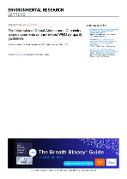The International Global Atmospheric Chemistry project comments on the revised WHO air quality guidelines

Autor
Paton-Walsh, Clare
Subramanian, R.
Crawford, James H.
Dawidowski, Laura
DeWitt, H. Langley
Emberson, Lisa
Emmons, Louisa
Garland, Rebecca M.
Kanaya, Yugo
Mbandi, Aderiana
Pratt, Kerri A.
Rojas, Nestor Y.
Salam, Abdus
Sinha, Vinayak
Toure, N'Datchoh Evelyne
Yu, Liya E.
Zheng, Mei
Datum vydání
2023Publikováno v
Environmental Research LettersRočník / Číslo vydání
18 (11)ISBN / ISSN
ISSN: 1748-9326Metadata
Zobrazit celý záznamKolekce
Tato publikace má vydavatelskou verzi s DOI 10.1088/1748-9326/ad039f
Abstrakt
In September 2021, the World Health Organization (WHO) announced updated global air quality guidelines providing health-based targets for six key air pollutants [1]. The annual targets for pollutant concentrations were reduced fourfold for nitrogen dioxide (NO2) to 10 µg m-3 and by 50% and 25% respectively for the mass concentration of particles smaller than and equal to 2.5 µm (PM2.5) and 10 µm (PM10) to 5 µg m-3 and 15 µg m-3. New targets were introduced for peak season ozone (O3) at 60 µg m-3 and daily carbon monoxide (CO) at 4 mg m-3. In contrast, the target for sulfur dioxide (SO2) was relaxed by a factor-of-two [1] to 40 µg m-3. The new guidelines also have updated interim targets.As we show in the following paragraphs, because of atmospheric chemistry and meteorology, these new guideline values can be unattainably low for some pollutants, are too high for other pollutants, and may be jointly unattainable for a key pair of pollutants for some cities. The International Global Atmospheric Chemistry project (IGAC) [2] provides a platform through which in-country scientists can be supported to help their local air quality management agencies determine if any of these specific conditions apply and if so, how to set appropriate national standards.
Klíčová slova
International, Global, Atmospheric, Chemistry, project, comments, revised, WHO, air, quality, guidelines
Trvalý odkaz
https://hdl.handle.net/20.500.14178/2333Licence
Licence pro užití plného textu výsledku: Creative Commons Uveďte původ 4.0 International






